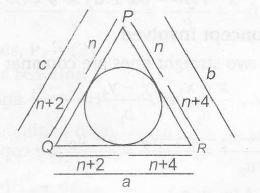Answer:
Option B,D
Explanation:
Concept involved
When ever cosine of angle and sides are given or to find out , we should always use cosine law
i.e, $\cos A= \frac{b^{2}+c^{2}-a^{2}}{2bc}$
$\cos B= \frac{a^{2}+c^{2}-b^{2}}{2ac}$
$\cos C= \frac{a^{2}+b^{2}-c^{2}}{2ba}$

$\therefore$ $\cos P= \frac{b^{2}+c^{2}-a^{2}}{2bc}$
$\Rightarrow \frac{1}{3}=\frac{(2n+4)^{2}+(2n+2)^{2}-(2n+6)^{2}}{2(2n+4)(2n+2)}$
($\because$ cos P= $ \frac{1}{3}$)
$\Rightarrow \frac{4n^{2}-16}{8(n+1)(n+2)}=\frac{1}{3}$
$\Rightarrow \frac{n^{2}-4}{2(n+1)(n+2)}=\frac{1}{3}$
$\Rightarrow \frac{(n-2)}{2(n+1)}=\frac{1}{3}$
$\Rightarrow$ 3n-6=2n+2 $\Rightarrow$ n=8
$\therefore$ sides are 2n+2, 2n+4,2n+6
$\Rightarrow$ 18,20,22